This was published 8 years ago
Greenland to Canada Arctic cruise review: Awesome close encounters
By Steve Meacham
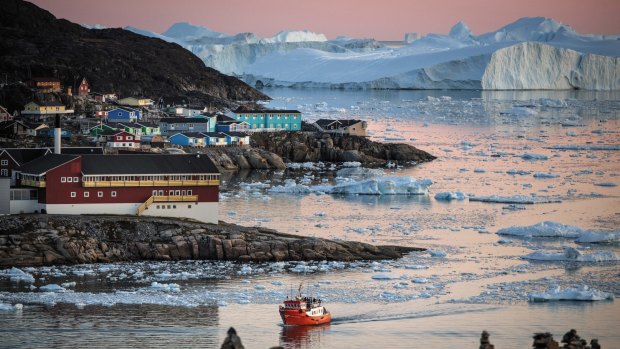
Heading ashore.
Monumental Island, at the base of the Davis Strait in the Canadian Arctic, is an inhospitable rocky outcrop named by explorers searching for Sir John Franklin's final doomed expedition which had set out to discover the famed Northwest Passage.
"There's not going to be any wildlife here, except for the birds," says my kayak partner, John, a retired teacher from Victoria. "Look how barren it is."
I agree, and we continue paddling along the rugged shoreline with the rest of our kayak flotilla, all of us desperate not to overturn in the near freezing water. Then John suddenly announces, "See that white patch of snow over there? I think there's a polar bear just above it."
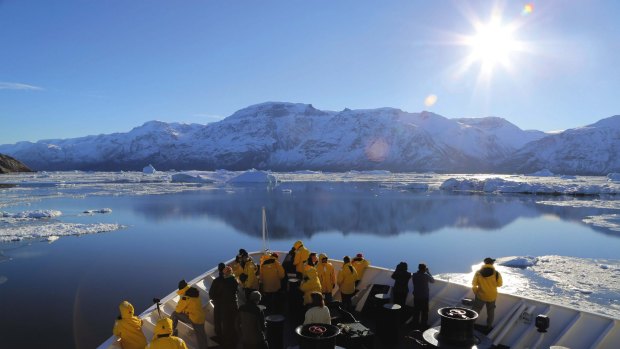
Cruising the Arctic waters.
Sure enough, Val – our charismatic Canadian kayak guide – gets a radio message from Alex, the expedition leader who is up ahead in an inflatable Zodiac. There are actually two bears, a mother and almost full grown cub, up on the ridge.
By the time we seven kayakers have paddled to the Zodiacs carrying the other passengers on our expedition, the curious bears have lumbered down to the patch of snow and are surveying this strange fleet of intruders. They seem unfazed, but we're not taking any chances and stay 50 metres offshore in case they decide to attack.
For 20 minutes, we're kept spellbound as the two bears cuddle one another, changing positions like overgrown puppies. The only sound is the clicking of cameras and a communal gasp of awe. We can't believe our luck, getting such a close sighting of polar bears on our first kayak excursion.
We've all had kayaking experience and can do a wet exit if we flip.
But the wonders haven't finished yet. A few minutes later, on the other side of the island, we discover a third bear, this time a large, well fed male. And then, as we are paddling back to our pick-up point, we get another treat – a pod of 40 walruses powering through the water, tusks showing, their heads bobbing up and down like Olympic butterfly swimmers. For a moment, we're scared. Val has warned us that walruses have been known to attack kayaks. But they shy away from us, and we head back to the Sea Explorer, our expedition ship, in the warm glow of contentment, despite the Arctic temperatures.
This day six encounter at Monumental Island was one of the most magical experiences of our 16-day exploration of western Greenland and the Canadian Arctic, but there were many others.
Flying over the beautiful white and blue landscape of the Greenland ice shelf, the biggest outside Antarctica. Marvelling at the power of massive glaciers and the dangerous serenity of a sea of icebergs. Visiting Inuit communities and learning how they have survived for centuries in some of the most remote and inhospitable parts of the world. Eating delicacies such as musk ox (surprisingly tender), raw seal (a bit like tuna sashimi) and minke whale (best avoided). Catching sight of bowhead whales, seals, caribou and Arctic fox.
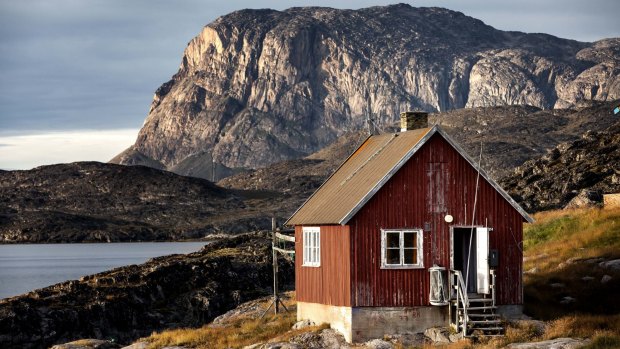
Away from it all in Greenland.
Our Peregrine Adventures trip, operated by Quark Expeditions, which has specialised in polar adventures since 1991, began in Copenhagen since Greenland is now an autonomous country under the Danish crown. We'd met at an airport hotel, were handed our distinctive yellow parkas, grabbed a night's sleep, then assembled early morning for the five-hour charter flight to Greenland's largest commercial airport at Kangerlussuaq, a former US military base.
There, we boarded several large snow buses which took us on a two-hour side trip past picturesque glacial lakes and raging meltwater rivers to the towering, 30-metre-high sculptural cliffs of the Greenland ice shelf.
Soon we were climbing aboard our first Zodiac to join the Sea Explorer, one of several ice-strengthened passenger ships which Quark charters for its polar voyages. Like most of my fellow passengers, I was amazed at how luxurious the Sea Explorer is, with spacious, wood-paneled cabins, spa, gym, elegant dining room, lecture theatre, bar and a well-stocked polar library. A far cry from the spartan icebreaker I was expecting.
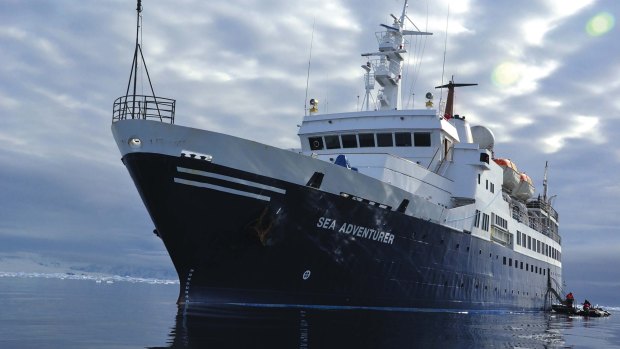
The Sea Explorer.
The ship can take 111 passengers and this trip is the first time Quark has used it on this particular itinerary, combining Greenland and Canada's iconic Hudson Bay. Many of my fellow passengers are polar veterans and they've chosen this voyage because of the opportunity to visit Inuit communities which have not seen a cruise ship in years.
After settling into our cabins, most of us assemble on deck to admire the scenery as the Sea Explorer sets sail along Sondre Stromfiord, the longest fiord in Greenland. Then it's time to gather in the lecture theatre to meet the expedition team. Alex McNeil, the Canadian expedition leader, introduces them individually.
From the first meeting, McNeil stresses that this is an expedition, not a normal cruise. While he and the Sea Explorer's Ukrainian-born captain will try to deliver everything in the itinerary, where we go and what we do will depend on the weather and the wildlife. Before each trip ashore, McNeil and his team will go ahead. If they see polar bears, we're not allowed to land. If they don't, we're allowed to walk in a group protected by team members carrying rifles. A dead polar bear would be a disaster, he says, and would be the result of a passenger not following instructions.
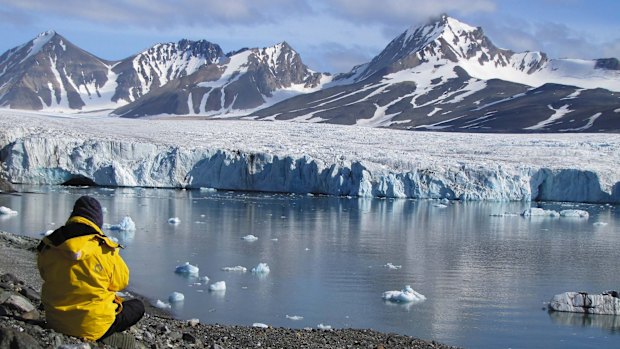
Taking in the icy scene.
After dinner (soup, salad, main course, dessert with complimentary wines and beers), the 10 of us who have signed up in advance and paid the extra $645 for the kayak option have a separate briefing from Val. We've all had kayaking experience and can do a wet exit if we flip – but none of us want to practise it in Arctic waters. Val says she hopes to get us out on the water four or five times on the trip (we actually do five), but sometimes we'll have to join a Zodiac cruise if the water is too rough.
Soon we settle into a daily routine. Wake-up briefing at 7am, breakfast on the sun deck if it is not too cold, followed by a community visit, Zodiac cruise/kayak or trek in which we split into four different groups – chargers, medium fast, medium slow, contemplative – depending on how active we want to be. After a three-course lunch, there might be another excursion, or a lecture if the weather isn't suitable or we're at sea. At 6.30pm we gather for the nightly recap meeting, relax over dinner then retire to the bar where there is often a quiz, competition or humorous talk.
Obviously, you can skip any of the activities – but most passengers seem to enjoy the crowded schedule and the chance to learn more about the Arctic.
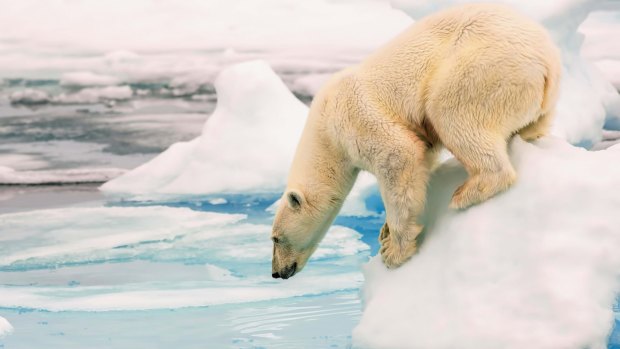
A polar bear prepares to dive in.
The route initially takes us up the east coast of Greenland to multicoloured, picturesque Sisimiut, the country's second largest settlement with 6000 residents, most of them employed in the fishing industry, with shrimp, crab, cod and halibut exported around the world. We then head further north to see one of Greenland's biggest tourist attractions, the 40 kilometre-long Ilulissat ice fiord , fed by the northern hemisphere's fastest tidewater glacier. That evening, as the Sea Explorer leaves Greenland to head across the Davis Strait to Canada's Baffin Island, we're treated to one of the most spectacular sights of the trip – a sea of icebergs, sparkling in the bright summer sun.
On the western side of the strait, we follow the Baffin Island coastline, stopping to explore islands where we see more polar bears (I spotted nine in all on the trip, most of them in the distance) and plenty of birdlife, particularly the thick-billed murre.
In the Hudson Strait, we pass a gigantic, flat-topped iceberg which Colin, our expedition glaciologist, tells us is extremely rare this far south. An hour later, two bowhead whales entertain us for half an hour as they repeatedly dive and resurface in front of the ship.
We also visit two Canadian Inuit communities in the Hudson Strait – Kimmirut and Cape Dorset. The people of Kimmirut give us a tremendous welcome, putting on a display of Inuit sports and preparing a series of local delicacies, including raw seal. Our time at Cape Dorset, by contrast, is mainly spent visiting half a dozen art galleries selling carvings and prints by local artists whose work is much sought after in Toronto and Montreal.
Day 10 sees the Sea Explorer enter Hudson Bay, and for the next four days we visit various islands for more wildlife sightings. We're particularly keen to spot two of the most spectacular ice whales – the white dolphin-related beluga whale and that most curious unicorn-like creature, the narwhale (or narwhal). They elude us, but we relish an hour spent watching a "haul out" of 30 or more walruses, luxuriating on the rocks in the afternoon sun.
On day 15, we're due to disembark the Sea Explorer at Churchill, the Hudson Bay port that is closed to shipping for four months of the year because of ice. From there, we'll take the five-hour charter flight to Toronto for the last night together before we go our separate ways, so there's a party atmosphere on our last night aboard.
I'm in bed at 12.30am when an announcement comes over the tannoy. Jake, an expedition guide, apologises for disturbing us but says the Northern Lights can be seen off the port side. By the time I reach the viewing deck, they've faded to a green, rainbow-shaped shadow. But at least I've seen them, and it seems a fitting end to a great adventure.
The next day, as the Sea Explorer passes Cape Churchill, there is one final, unforgettable surprise. Four thousand beluga whales are feeding at the mouth of the Churchill River. Alex announces that there's time for an unscheduled Zodiac cruise. Soon we're out on the choppy water, surrounded by these graceful white mammals, many of which swim right past us. As an Arctic finale, it doesn't get any better.
TRIP NOTES
MORE INFORMATION
GETTING THERE
Qantas and Emirates fly to Copenhagen from Sydney and Melbourne via Dubai. Qantas and American Airlines fly from Copenhagen to Sydney and Melbourne via Los Angeles. See www.qantas.com.au
CRUISING THERE
Peregrine Adventures' 13-day Greenland to Canada voyage starts in Ottawa and ends in Montreal in 2016, visiting West Greenland with a possible landing at Monumental Island. Departure September 12, from $11,400 a person.
A second 2016 trip, the 20-day Northwest Passage departing on August 26, costs $18,800 a person and can be combined back-to-back with Greenland to Canada.
SEE + DO
If you've kayaked before, consider paying the $645 supplement to join the kayak excursion team. It's a magnificent way of experiencing the Arctic wildlife at your own pace.
The writer was a guest of Peregrine Adventures.
Sign up for the Traveller Deals newsletter
Get exclusive travel deals delivered straight to your inbox. Sign up now.